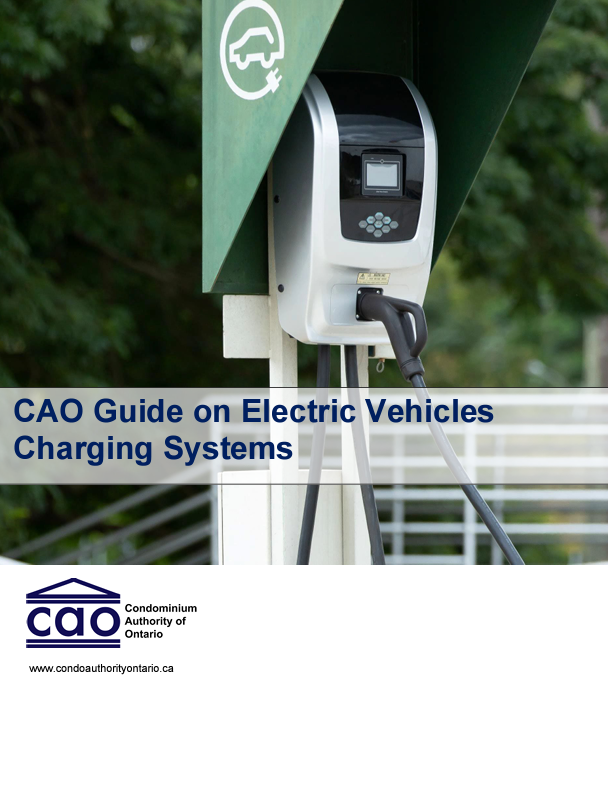GUIDE
CAO Guide on Electric Vehicles Charging Systems
As more people start using Electric Vehicles, EV Charging systems become an important part of condo living. In 2018, the province established new approval processes for installing Electric Vehicle Charging Systems in condo buildings that owners and corporations can follow.
The Condominium Authority of Ontario has prepared a step-by-step guide for owners and boards on how to install Electric Vehicle Charging Stations, in addition to templates to assist owners in applying for and boards in responding to EVCS installations.
Introduction
This section of the guide provides an introductory overview of the installation process of Electric Vehicle Chargers in a condominium. It also provides information on:
- Approval Process
- Related Rules
- Key Considerations
Installation initiated by the corporation
Condo corporations may require a vote by the owners if they want to install electric vehicle charging systems in their building.
1. No vote required by owners
Corporations don’t need a vote if the estimated cost of the installation is less than 10% of the annual budgeted common expenses or they believe that owners will not regard the installation of the EVCS as negatively impacting the use and enjoyment of units, common elements, or assets of the corporation.
The corporation must send a notice to the owners at least 60 days before the installation begins. This notice to owners must contain the following:
- A description of the proposed installation
- Estimated costs of the EVCS installation and a description of how the corporation will pay for the costs
- A statement indicating that the board believes that the owners would not consider the installation of the EVCS to constitute a significant reduction or elimination of the use or enjoyment of units, or of common elements, or assets of the corporation
- Any other information that the by-laws of the corporation require
Please note: If the corporation will be doing the installation, all associated costs associated are considered common expenses of the corporation. Accordingly, all owners are responsible for paying for this through condo fees, as per the condo corporation’s declaration.
2. Possible vote by owners
A vote by owners is required if the estimated cost of the installation is more than 10 per cent of the annual budgeted common expenses or if the board thinks that the owners might consider the installation of the EVCS to significantly impact their enjoyment of the units, common elements, or assets of the corporation.
In these scenarios, the corporation must send a notice to the owners notifying them of the plan to install an EVCS with:
- A description of the proposed installation
- Estimated cost of the EVCS installation and a description of how the corporation will pay for the costs
- A statement that the board believes that the owners would regard the installation of the EVCS as causing a material reduction or elimination of the use or enjoyment of the units that they own or the common elements
- A statement that the owners have a right to requisition a meeting within 60 days of receiving the notice
- A copy of section 46 of the Act and section 24.2 of Ontario Regulation 48/01
- Any other information that the by-laws of the corporation require.
Once the notice has been sent, the corporation can only proceed with the installation of the EVCS if:
- The owners have not requisitioned a meeting within 60 days of receiving the notice
- A meeting was requisitioned and held, but quorum was not met
- A meeting was requisitioned, held, quorum was met and the owners did not vote against the installation of the EVCS
Installation initiated by condo owner
Any owner who wants to install an EVCS must follow these steps:
Step 1: Written application
The owner must submit an application to the corporation that:
- Identifies the owner and the owner’s address for service
- Is signed by the owner
- Includes drawings, specifications and information relating to the proposed installation.
The corporation has an obligation to respond in writing and to assist the owner in meeting the above requirements.
Step 2: Decision
The corporation will have 60 days to respond once the application has been submitted. This timeline can be extended if the owner and the corporation agree to it.
The corporation can only reject the request for installation if, based on the opinion or report of a qualified professional:
- The installation would be in violation of the Condo Act, or any other legislation
- The installation would adversely affect the structural integrity of the property
- The installation poses a health and safety risk to the property and its occupants.
Condo corporations are required to provide a copy of the report or opinion of the qualified professional to the owner if they reject the application.
If none of these reasons apply, the condo corporation must accept the application or propose an alternative installation plan that does not result in unreasonable costs to the owner.
Step 3: Agreement
The owner and the corporation have 90 days to enter into a written agreement after the corporation has accepted the application. The agreement must outline who is responsible for the any costs related to the installation.
The owner is generally responsible for all installation-related costs if they submit an application unless stated otherwise in the written agreement.
Once the condo corporation and the owner have a written agreement, the condo corporation must register the agreement on the title of the owner’s unit. The agreement will not take effect until this happens.
Disputes
Any disagreement between an owner and the condo corporation must be submitted to private mediation and arbitration within six months. If the dispute is not raised within six months, the owner’s application is considered to have been abandoned.
